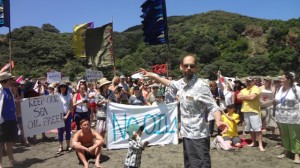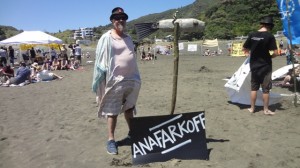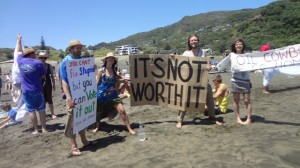 Around a thousand gathered on Piha Beach on 23 November in the Banners on the Beach protest against deep sea oil drilling. When the crowd lined up facing out to the Tasman where the Greenpeace protest boat Vega was confronting Anadarko’s exploration ship Noble Bob Douglas, the line stretched from Pakiti Rock to Lion Rock several people deep. A spine-chilling haka by local surfers sent a clear message from land to sea.
Around a thousand gathered on Piha Beach on 23 November in the Banners on the Beach protest against deep sea oil drilling. When the crowd lined up facing out to the Tasman where the Greenpeace protest boat Vega was confronting Anadarko’s exploration ship Noble Bob Douglas, the line stretched from Pakiti Rock to Lion Rock several people deep. A spine-chilling haka by local surfers sent a clear message from land to sea.
Anadarko is the company responsible for the Gulf of Mexico spill in 2010, at 650,000 tonnes, the worst oil spill in human history. Off Raglan, Anadarko is drilling in 1800 metres of water ” the previous deepest offshore drilling in New Zealand is 120 metres ” leading to fears that in the event of a failure regaining control would be a formidable engineering challenge and the cost of failure could be catastrophically high.
 At Piha, Greenpeace’s Steve Abel MC’d, leading the crowd in some No drill, no spill chants, and the chair of the Waitakere Ranges Local Board, Sandra Coney, read a message from the Vega, saying it has been a huge inspiration for us to know New Zealanders are mobilising on dozens of different oil-free beaches. The fight is moving from sea to land…
At Piha, Greenpeace’s Steve Abel MC’d, leading the crowd in some No drill, no spill chants, and the chair of the Waitakere Ranges Local Board, Sandra Coney, read a message from the Vega, saying it has been a huge inspiration for us to know New Zealanders are mobilising on dozens of different oil-free beaches. The fight is moving from sea to land…
Many had made their own banners with slogans such as It’s not worth it, Don’t spoil with oil, No Friggin Riggin, and Love Piha the way it is. Similar protests occurred at beaches up and down the coast ” including Karekare, Whatipu, Te Henga, Raglan, and as far away as the South Island.
Anadarko is drilling 100 nautical miles off the coast, but recently the Government consulted on Block Offer 2014, preparatory to receiving applications for permits to drill far nearer the coast. Block Offer 14 comprises huge areas (434,000 sq kms in total) of the New Zealand coastline, including the West Coast of the North Island from Taranaki to beyond North Cape, from around six nautical miles offshore to further out to sea.
 Exploration activities include seismic surveys, sampling, aeromagnetic surveys, exploratory drilling and geological studies. If a discovery is made, a company can then apply for a mining permit.
Exploration activities include seismic surveys, sampling, aeromagnetic surveys, exploratory drilling and geological studies. If a discovery is made, a company can then apply for a mining permit.
Of course, six nautical miles would be visible from Piha and there are fears that the seismic effects of drilling would harm Maui’s dolphins, who use echolocation to navigate, communicate and find food. At only 55 remaining, Maui’s is the rarest dolphin in the world, and on the verge of extinction.
An oil spill would have a devastating effect on the dolphin, but also on all marine life. The Kaipara Harbour snapper nursery is estimated to provide 95% of the West Coast snapper stock. An oil spill which reached the shore would be highly damaging to the recreational values of the coastline, which boasts surf breaks which are protected and would any notion that the West Coast is a natural wilderness.
Mopping up an oil spill would be a near impossible task on the West Coast, with high cliffs preventing access to the shoreline and a lack of road access for long stretches. The high-energy coast would also mean approach by sea would be impossible much of the time.
The Government consulted the Auckland Council on Block Offer 2014 and the Council expressed its concern about the Maui’s dolphin, asking that the seaward boundary of the Block Offer be shifted to 12 nautical miles out to sea. The Waitakere Ranges Local Board has written to Simon Bridges, Minister of Energy and Resources, opposing oil drilling off the West Coast altogether. Christchurch City Council expressed opposition to Block Offer 2014 while Dunedin City Council consulted its community and said 199 or 227 submissions opposed oil drilling. The Government is yet to say how it is responding to submissions.
On 5 December the Government let further deep sea oil drilling permits.
For more on oil drilling go to www.greenpeace.org/new-zealand



